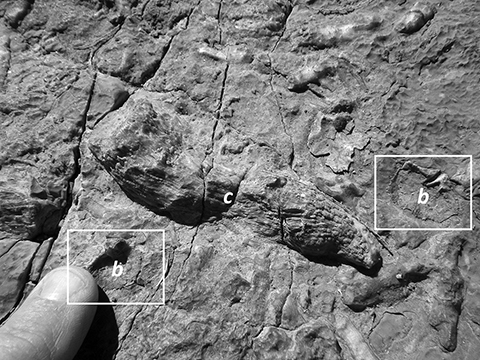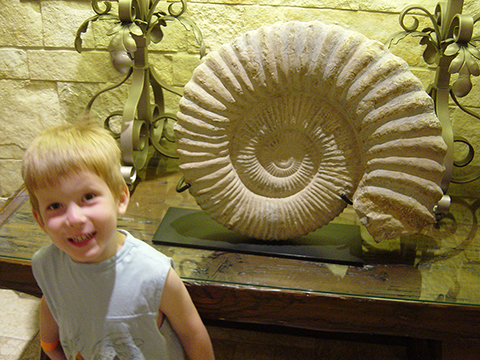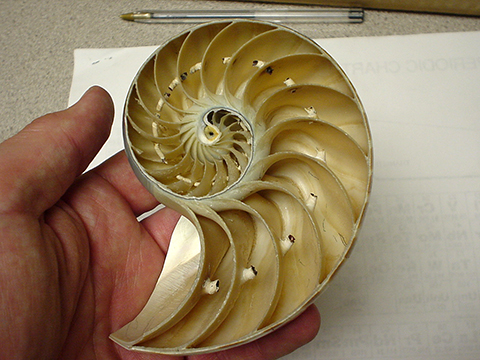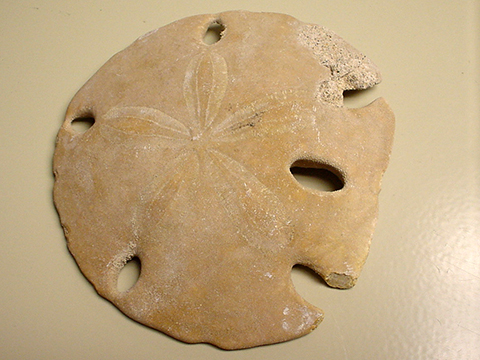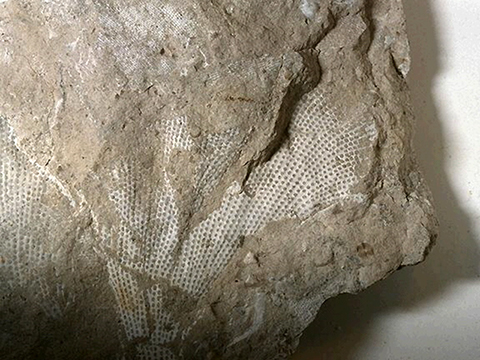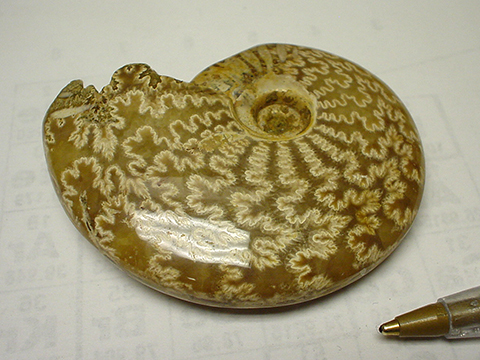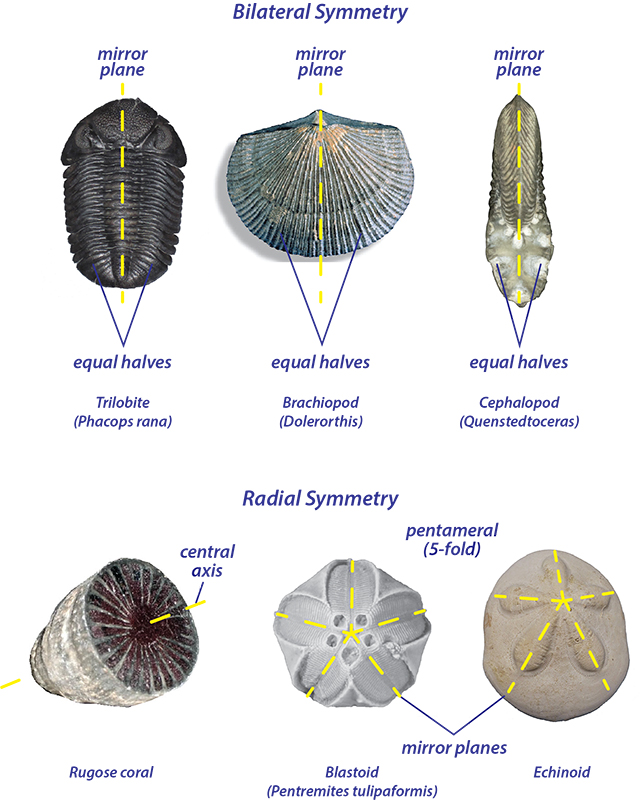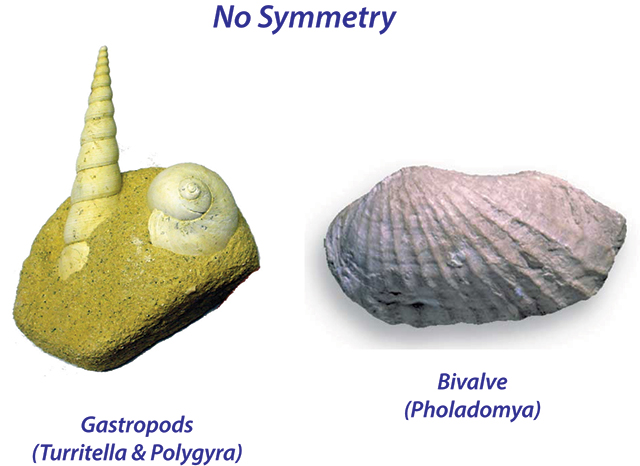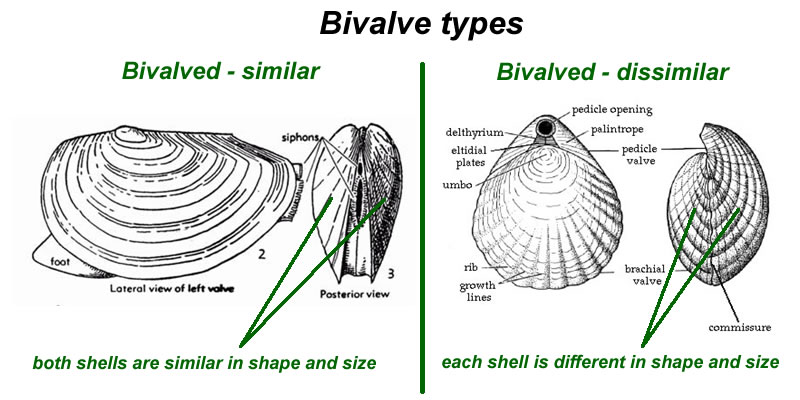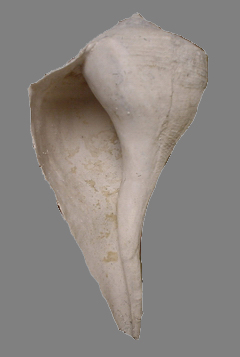Part C
Identifying Invertebrate Fossils
There are many different types of fossils, but most are identified based on their morphology (shape or form). Before you start identifying specific fossils, it's good to get familiar with their basic shapes.
|
Figure 6-5. Fossils small and large. Rugose coral (c) and brachiopods (b) in the upper Redwall Limestone just below 24.5-Mile Rapids in the Grand Canyon (left). |
|
Describing Fossils
Fossilization favors the preservation of marine organisms, which are commonly made of durable hard parts. This lab specifically involves some common marine invertebrate fossils, meaning ones lacking a spinal cord. Since fossil identification is mainly based on morphology (shape or form), you need to get familiar with the basic shapes of fossils. A brief review of fossil shapes and symmetries is shown in Figures 6-6 through 6-10.
|
Figure 6-6. There are many different types of fossil shapes and symmetries. Some fossils are coiled about an axis (left), whereas others can be divided into equal parts (right). |
|
General Morphology
First of all, a fossil's form can be described as either colonial or solitary (see Figure 6-7). A fossil can represent a group of attached organisms (colonial) or an individual (non-colonial or solitary).
Colonial
> Represents a group of attached organisms that live together.
> Familiar examples of colonial organisms include most corals, sponges, and bryozoans.
Solitary (non-colonial)
> Represents an individual organism.
> Many types of fossils are solitary, including trilobites, brachiopds, horn corals, etc.
> If a fossil is non-colonial, then you can describe its symmetry and its shape.
Symmetry
Next, a fossil's shape may be described by having symmetry (or not) or even distinctive patterns. There are several basic types of symmetry, which may be defined as a one or more lines or planes that divide a fossil into equal parts (see Figure 6-8).
Bilateral
> Fossils that can be divided into two equal halves (like mirror images) have bilateral (2-fold) symmetry.
Flat-coiled (planispiral)
> Some fossils are coiled about an axis in a single plane (planispiral). This is a type of bilateral symmetry.
Radial
> Some fossils that are symmetrical about a central axis have radial symmetry and may be shaped like a cup, cone, horn, etc.
> Pentameral (5-fold) is a type of radial symmetry involving five mirror planes radiating from an axis (e.g., sand dollars, starfish). In some instances, organisms may display both a radial symmetry and a secondary bilateral symmetry.
Elongated
> Some fossils are mostly long and slender, tubular or cigar-like in shape. These may also have bilateral or radial symmetry.
|
|
|
Figure 6-8. Types of fossil symmetry. |
No Symmetry, But Distinctive Shape
Some fossils may lack symmetry, but possess a distinctive shape (see Figure 6-9).
Cone-shaped coiled
> Fossils can be coiled and extended about an axis, giving them a cone-shape. These types of fossils have a distinctive shape, but lack symmetry.
Other shapes
> There are a variety of other distinctive fossil shapes that have no symmetry. For example, a single bivalved pelecypod shell is recognizable as a "clam shell", but lacks any symmetry.
|
|
|
Figure 6-9. Fossils with no symmetry. |
Bivalves
Fossils made of two shells that can open and close are called bivalves (see Figure 6-10). These shells are referred to as bivalved-similar if both shells are similar in size and shape (e.g., pelecypods), whereas bivalved-dissimilar describes shells that are of different size or shape (e.g., brachiopods).
Bivalved - similar
> A bivalved fossil with both shells nearly equal in size is described as bivalved-similar. Each individual shell of a bivalved-similar fossil typically lacks bilateral symmetry (with rare exception). Thus, bivalved-similar fossils consist of two equal-sized shells, each having no symmetry.
Bivalved - dissimilar
> A bivalved fossil with two shells that are different size or shape is described as bivalved-dissimilar. Each individual shell of a bivalved-dissimilar fossil typically have bilateral symmetry. Thus, bivalved-dissimilar fossils consist of two different-sized shells, each having bilateral symmetry.
Refer to Figures 6-7 to 6-10 to answer Quiz Me! questions C11 through C20.
![]()
![]()
![]()
![]()
![]()
![]()
![]()
![]()
![]()
![]()
Fossil Identification
One of the easiest fossil identification methods involves using what is called a dichotomous key, where the identity of the fossil is discovered by progressively answering a series of questions about the fossil's shape. A key to identifying common invertebrate fossils is described in the Fossil Identification Key (see the PDF HERE), courtesy of Poort and Carlson (1998). You can print this PDF file and use it in the following fossil identification process.
You can also refer to the Fossil Reference PDFs (from Part B) to help identify the Phylum (and maybe Class) of the fossil sample, and for other specific information (Class, Order, specific or general name, etc.) about the fossil. These PDF file have pictures of the fossils that may or may not look similar to your fossil sample.
To summarize the identification process for invertebrate fossils:
1. Determine whether the fossil is colonial or solitary.
2. Identify the basic shape or type of symmetry (or lack thereof) of the fossil.
Colonial vs. Solitary
> COLONIAL - If the fossil is colonial, it's probably a sponge (Phylum Porifera), coral (Phylum Cnideria), or bryozoan (Phylum Bryozoa), which typically have distinctive shapes.
> SOLITARY - If the fossil is solitary, then you'll need to determine its shape and possible symmetry.
Solitary with no symmetry, but distinctive shape
> A solitary fossil with a cone-shaped coiled shape = gastropod (Phylum Mollusca, Class Gastropoda).
> A bivalved fossil where each shell lacks bilateral symmetry = bivalve or pelecypod (Phylum Mollusca, Class Bivalvia).
> A fossil with a tube shape may represent many organisms or features, worm burrow casts, etc.
Solitary with bilateral symmetry
> A solitary fossil with bilateral symmetry and composed of three, segmented lobes = trilobite (Phylum Arthropoda, Class Trilobita).
> A solitary, flat-coiled (planispiral) fossil with bilateral symmetry = ammonoid cephalopod (Phylum Mollusca, Class Cephalopoda). These have a chambered internal structure with the folded septa (chamber walls) that form complex suture patterns (formed where the septa meet the inner shell wall).
> A solitary, elongated fossil that is long and slender with a tapered shell (cigar-shaped) that may range from curled to straight = nautiloid cephalopod or belemnite (Phylum Mollusca, Class Cephalopoda). Nautiloids also have a chambered internal structure with the smooth septa (chamber walls) that form simple suture patterns (formed where the septa meet the inner shell wall).
> A bivalved fossil where each shell has bilateral symmetry = brachiopod (Phylum Brachiopoda).
Solitary with radial symmetry
> A solitary fossil with radial symmetry (relative to a central axis) that is horn- or cup-shaped = rugose coral or "horn coral" (Phylum Cnideria, Class Anthozoa, Order Rugosa).
> A solitary fossil with pentameral or (5-fold) symmetry = an echinoderm (Phylum Echinodermata). There are several distinctive echinoderm types: crinoids (Class Crinoidea), blastoids (Class Blastoidea), and echinoids or "sand dollars" (Class Echinoidea).
|
Example 1 |
|
|
|
Name this fossil. |
|
1) This a solitary (noncolonial) fossil. 2) It is cone-shaped-coiled about an axis. Thus, it is likely a member of Phlyum Mollusca, Class Gastropoda. |
|
Gastropod (specifically Busycon) |
Now, let's try to identify 10 different fossils.
![]()
![]()
![]()
![]()
![]()
![]()
![]()
![]()
![]()
![]()
